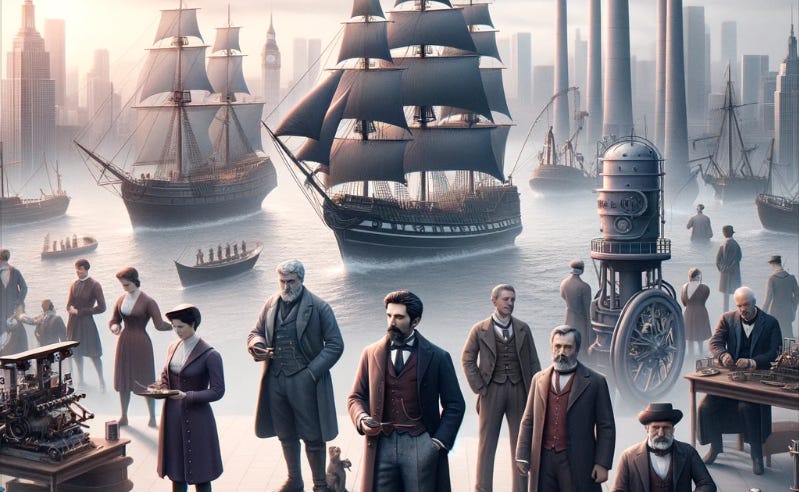Econ 115 :: The World Economy in the 20th Century :: Lecture 3 :: Breaking Out of Agrarian-Age Near-Stagnation
The slides from the third lecture of my first post-big book excursion through the economic history of the 20th century; a very quick & inadequate runup to how human society arrived at the 1870 hinge of history…
Slides:
2024-01-23 Tu: Breaking Out of Agrarian-Age Near-Stagnation
Readings:
Wyman, Patrick. 2021. The Verge: Reformation, Renaissance, and Forty Years that Shook the World. New York: Twelve <https://www.amazon.com/Verge-Reformation-Renaissance-Forty-Years-ebook/dp/B08P1MF813>.
Engels, Friedrich. 1880. Socialism: Utopian and Scientific. Paris <https://archive.org/details/socialism-utopian-and-scientific-friedrich-engels>.
Lecture Highlights:
Courtesy of Sub-Turing BradBot: The lecture begins by setting the context of the 20th century, highlighting the dramatic increase in the rate of technological progress around the 1870s, marking a significant change in human history and society. The lecture discusses the transition from agrarian societies to modern age societies characterized by economic growth, technological advancement, and changes in social structures and governance.
Key topics include:
Technological Progress: The importance of the increase in the rate of technological progress from the agrarian age to the modern age. This transition resulted in societies where technological competence doubled every generation, profoundly impacting social arrangements and the nature of human societies.
Demographic Transition: From high birth and death rates to lower rates, resulting ultimately in slower population growth after the population explosion. This shift is explored in the context of societal changes in women’s roles and reproductive choices.
Historical Comparisons and Shifts: The lecture draws comparisons between historical figures to illustrate changes in societal values and activities. For instance, it contrasts the life and contributions of William Marshall, a medieval knight, with those of William Gates (Bill Gates), highlighting the shift from a focus on physical combat and domination to technological innovation and entrepreneurship.
Economic and Social Changes: The transformation of societies from being static and dominated by a small predator and extractive élite to more dynamic and potentially more egalitarian form. Is it possible to imagine a transformation of the role of government from that of being focused on the domination of human over human to one of the coordination of egalitarian productive and distributive processes?
Global Interactions and their Impacts: Technology transfer, cultural exchanges, and societal development. How was it that Dover-Circle cultures, despite being technologically and organizationally backward around 1500, turned out to be the places where the breakthrough to modern economic growth occurred?
The summary of the previous lecture’s key points covers the historical significance of the year 1870, the slow growth of technology in the agrarian age, demographic pressures, and the nature of societal dominance and exploitation. It also highlights the mighty accomplishments of past civilizations, using the example of the Athenians constructing a 30-foot bronze statue of Athena, Athene Promakhos, showcasing their extraordinary organizational capabilities—yet next to nothing of what we call economic growth.
This lecture’s required readings are Wyman and Engels:
The selections from Wyman’s book The Verge depict of Europe in 1500 as technologically and organizationally backward yet uniquely positioned for innovation, in part due to its disorganization. This contrasts with the more centralized and hierarchical civilizations along the arc of the rest of Eurasia south of the steppe.
For example, Isabella I Trastámara, of Queen of Castile, and her cousin João II Aviz, King of Portugal, were able, remarkably, to assemble resources for exploration and conquest as much from outside as from inside theirr relatively small and fractious kingdoms. Over and over and again and again after 1500, Europeans were able to mobilize, enormous resources for exploration, conquest, and economic development, not so much through command and control, but through contract and buying in a way, not found anywhere else in the world. Wyman gives us a view of this process at its ground floor.
Friedrich Engels, Karl Marx’s close associate, observes the transition from a feudal-agrarian to commercial-gunpowder society. Engels pondered the societal implications of this shift—from, in Henry Maine’s words, status to contract. Engels looked forward to the culmination of the transition, ongoing in his life, from commercial-gunpowder to steam-powered society. He tried to see how changing industrial organization and technology would shape future social structures. He envisioned a utopian socialist society where government would transition from human domination to coordination of mutually beneficial production processes.
The focus of this third lecture is the dramatic shift from static, slow-growing, poverty-stricken, and highly unequal societies of the agrarian age to the modern age. This new era is typified by economic growth and the possibility of a more equitable distribution of resources, as well as the potential for a shift in the role of government from domination to coordination.
Two key factors facilitated this transformation:
the acceleration of technological progress
the demographic transition.
Population growth and technological progress from -6,000 to 1500 was exceedingly slow. And the period between 150 and 800 AD is noted for a slowdown in progress, with the decline of the Roman and Han empires.
Technological progress increased from a mere 6% per century during the agrarian age to about 2% per year in modern post-1870 times. This change meant that each generation witnessed new technologies and societal structures, a stark contrast to previous eras where centuries passed with little change. The demographic transition, our topic for Thursday, is another major factor. It describes the shift from women having numerous pregnancies with few surviving children, to our current era where the average woman has fewer than two children. This transition, alongside technological advancements, contributed to a massive population growth from 500 million in 1500 to 8 billion today. Technological capabilities have far outpaced population growth, leading to a world where basic necessities are no longer luxuries.
This matters—or might matter—a lot. Consider the contrasting life paths of William Gates in the 1970s and William Marshall in the 1150s, as exemplifying the societal shift from the agrarian to the modern age. Gates, pursuing technology and innovation, contributed significantly to societal advancement, while Marshall was a thug, making his way via the warrior class’s dominance.
Even before 1870, the world had transitioned from a 6% per century technological growth rate before 1500 to about one-third of a percent per year in the century aftrer 1870.
From 1500 onwards, the Columbian Bioresource Exchange and trade globalization somewhat accelerated technological progress. The introduction of crops like corn and potatoes from the Americas to Europe and the global spread of manufacturing are noted as key drivers of change. The availability of coal in England and the development of the steam engine were also critical factors, driving significant advancements such as railroads and telegraphs. But these not sufficient to substantially improve living standards or reduce infant mortality rates by much: not enough for a departure from Malthusian constraints.
These pre-1870 changes in societal organization and the form of élite domination were significant. The transition from feudal or classical agrarian society to a commercial-gunpowder society was momentous. And approaching 1870 we saw the flourishing of a steampower society.
There is the perennial historical question of why these advancements occurred in Western Europe rather than in previously technologically and culturally advanced China, despite China’s early inventions like the compass, printing, and gunpowder. And read about commercial developments in Sung and then Ming Dynasty China, and you could believe you were seeing a society on the verge of a true industrial revolution. But it was not to be the case.
Even within Europe, the technological and organization lead eventually grabbed by the “Dover Circle” is somewhat puzzling. As of 1500 what were to become the centers of Industrial Revolution society, like Manchester and London, were not inherently special compared to other wealthier areas of Europe at the time: Northern Italy, the Lower Rhine Valley, and Catalonia.
Yet it was from the Dover Circle societies, and their offshoots, that there came the changes that truly transformed and shaped the modern world. The Industrial Revolution Research Lab, the modern corporation, and the global market as they all emerged around 1870 were the final crucial developments. These innovations transformed the process of discovering, developing, deploying, and diffusing new technologies into a routine bureaucratic activity.
There were a very large number of earlier key moments and concepts that were essential contributors to the coming of modern technological progress and economic growth. These include the development of the machine tool industry and the engineering profession in the 1830s, the Hamiltonian approach to economic development in the early 19th century, and the shift in legal and political thinking around 1750 towards laws based on general utility and consent of the governed. Additionally, the invention of the steam engine around 1730 and the recognition of cotton’s industrial potential are noted as significant milestones.
And behind those we have the establishment of the capitalist mode of production the creation of the slave-sugar islands, the spread of global trade networks, and the introduction of new crops like potatoes and corn to Europe. There are the Magna Carta and the rule of law, plus the rise of individualism. All lie in the background. All were necessary. But only the full post-1870 institutional packeage was sufficient.
Questions from the audience asked about clarification and further expansion of the “gunpowder” part of Eurpean commercial society and gunpowder empires, focusing on Spain’s transition from wars reconquering Spain from Muslim powers to its exploration and conquest of the New World after 1492. Spain’s expansionist military culture shifting its focus. Ferdinand of Aragon concentrated on the Mediterranean and Italy. Isabella of Castile conquered cross the Atlantic. The Spanish conquistadors—and their Portuguese cousins—had a triple motivations: glorifying God, serving the king, and seeking riches. This combination of ideological, commercial, and political power was a key factor in their success. For example, consider the strategically and commercially important Strait of Malacca in the Indo-Pacific, with its regular monsoon winds facilitating trade. The arrival of the Portuguese in Malaysia, equipped with caravels capable of sailing against the wind, marked a significant shift in the balance of power.
Local rulers and merchants tried to fend off the coming of the Portuguese seaborne empire. Chinese merchants sought help from the Chinese emperor, who showed little interest in their plight: why should he care for merchants who had exited his kingdom? Similarly, appeals to the Sultan in Istanbul for aid against the Christian invaders were met with limited response, due to his military preoccupation with the Balkans. And there was no local emperor whom they could pledge allegiance to. Hence although there were commercial, religious, and military-political opposition to Portuguese expansion, there was no coördinated and unified response. This contrasted sharply with the Portuguese under the Duque de Alburquerque, who as viceroy effectively combined Portuguese military, commercial, and religious power in his pursuit of empire.
bCOURSES HOME PAGE: <https://bcourses.berkeley.edu/courses/1531168/>
Course Procedures: <https://bcourses.berkeley.edu/files/87866083/>
Course Schedule & Readings: <https://bcourses.berkeley.edu/files/87866231/
Econ 115 at Schedule of Classes. <https://classes.berkeley.edu/content/2024-spring-econ-115-001-lec-001>
Econ 115 Piazza signup link: <https://piazza.com/berkeley/spring2024/econ115>


